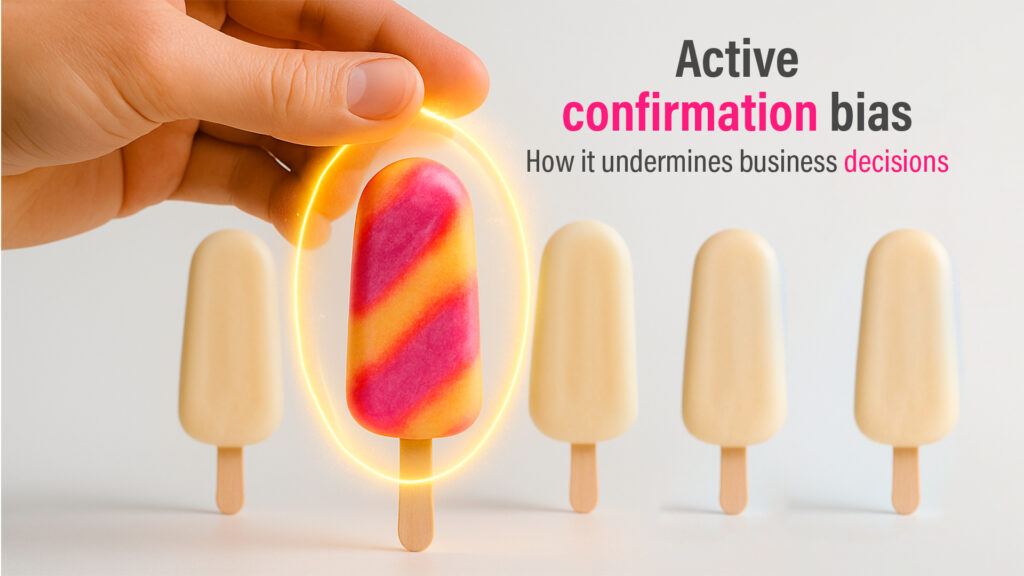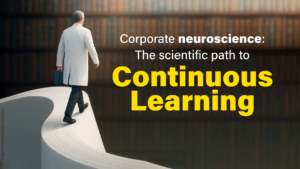
The Hidden Brain Trap Undermining Corporate Strategy
Confirmation bias in business decisions
Understanding Confirmation Bias in Business Decisions through Neuroscience
A growing body of research in cognitive science is reshaping how we understand decision-making in high-stakes environments. One of the most revealing recent contributions is the study titled “Humans actively sample evidence to support prior beliefs”, published in Nature Human Behaviour. It uncovers a powerful yet often invisible mental habit that should concern every leader and strategist: the tendency to selectively seek out and trust information that confirms existing beliefs and decisions—especially when confidence is high.
This is known as Confirmation Bias in Business Decisions, and it may be silently distorting strategies, blocking innovation, and reinforcing flawed assumptions within executive teams.
Confidence fuels selective thinking
The study found that when individuals make decisions and feel confident about them, they become more prone to actively filter information—not passively, but through deliberate attention and selective sampling. Rather than evaluating evidence with objectivity, the brain prioritizes inputs that align with previous choices, while minimizing or outright rejecting data that contradicts them.
This behavior intensifies when individuals have control over the information they access. In contrast, when data is externally curated—as in audits, peer reviews, or structured reporting systems—the bias tends to weaken. This has critical implications for how business leaders should structure their environments for strategic thinking.
In simple terms: the more control someone has over their information environment, the more vulnerable they are to confirmation bias—especially if they’re already confident in their choices.
Implications for leadership and strategic management
For executives, entrepreneurs, and decision-makers, the consequences of this bias are real and measurable. In day-to-day business practice, Confirmation Bias in Business Decisions can manifest as:
- Overcommitting to a failing strategy because the leader only sees reports that support it.
- Rejecting innovative ideas simply because they conflict with established mental models or company history.
- Ignoring early warning signs in financial, operational, or market data due to selective attention.
- Hiring or promoting based on alignment with one’s views rather than objective performance indicators.
In each case, it’s not that leaders are acting irrationally—they’re acting efficiently from the brain’s perspective. The brain is wired to reduce cognitive dissonance, conserve energy, and preserve a coherent self-narrative. But in complex, fast-changing business environments, these mental shortcuts can be catastrophic.
The neuroscience behind the bias
From a neuroscientific perspective, confirmation bias is linked to how the prefrontal cortex—especially regions involved in executive function and goal-directed behavior—processes information. When we make a decision, the brain creates a kind of “mental commitment” to that decision. New information is then evaluated based on how well it fits with that existing internal model.
Neuroimaging studies show that confirming evidence activates reward-related circuits, while disconfirming evidence often triggers regions associated with conflict and discomfort. That’s why it feels good to read an article that supports your view—and unpleasant to consider a perspective that challenges it.
This neural preference reinforces habitual patterns of thinking over time, especially in leaders who are consistently rewarded for decisiveness. The higher a person rises in an organization, the fewer opposing viewpoints they tend to encounter. Without intentional correction, this can create an echo chamber at the top.
Practical solutions for business environments
If confirmation bias is hardwired into the human brain, is there anything organizations can do about it? Fortunately, yes. While we may not eliminate the bias, we can design decision-making systems that reduce its influence:
- Create friction in information access: Encourage teams to present both supporting and contradicting evidence when proposing strategies. Build procedures where devil’s advocacy is not only accepted but expected.
- Rotate decision-makers: Changing who interprets data or leads strategic discussions can disrupt entrenched biases and bring fresh perspectives.
- Use structured frameworks: Decision matrices, premortems, red-teaming, and other formal tools can force a more balanced assessment of evidence.
- Cultivate psychological safety: When employees feel safe to speak up and challenge the status quo, cognitive diversity increases, and confirmation bias decreases.
- Separate analysis from advocacy: Assign distinct roles in meetings—some to advocate, some to evaluate—to prevent groupthink and ensure thorough scrutiny.
Reframing leadership through cognitive awareness
Understanding and addressing Confirmation Bias in Business Decisions isn’t just a matter of good governance—it’s a critical component of resilient leadership. Leaders who train themselves to ask disconfirming questions, tolerate cognitive discomfort, and systematically challenge their own beliefs are better positioned to adapt, pivot, and innovate in uncertain environments.
Moreover, this isn’t just about avoiding failure. It’s about unlocking higher-order thinking, improving strategic agility, and building cultures of continuous learning. In a world where the cost of a wrong decision can escalate rapidly, the competitive advantage will go to those who are not only smart, but self-aware.
Final thoughts
The study on how humans actively sample evidence to support prior beliefs is a powerful reminder: even the smartest minds are prone to subtle cognitive traps. In business, where information overload is constant and uncertainty is high, the ability to think critically and challenge assumptions is not optional—it’s essential.
The next time you feel sure about a business decision, ask yourself: What evidence am I not seeing? Or more importantly, What evidence am I choosing not to see?
That simple shift in awareness could be the difference between strategic clarity and a costly blind spot.
Kaanders P. et al. (2022). Humans actively sample evidence to support prior beliefs. eLife. PMID: 35404234. DOI: 10.7554/eLife.71768.
Continue reading more articles: https://neurobusiness.us/blog/


